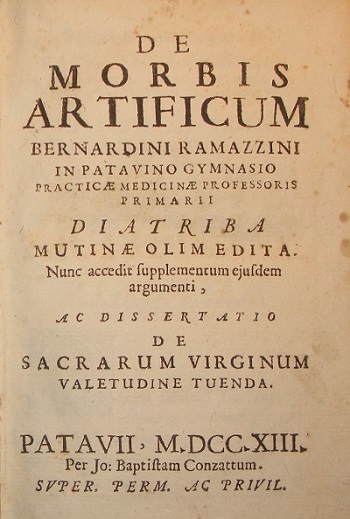Bernardino Ramazzini, born in Carpi in Emilia-Romagna in 1633, is often described as the “father of occupational medicine,” whose seminal contributions to the field continue to influence medical practice today. As an illustrious physician, Ramazzini’s pioneering work extended beyond the realm of occupational health, leaving notable impressions on the study of cancer and the treatment of malaria. He received his education at the University of Parma, and after years of dedication to the field of medicine, he was appointed chair of theory of medicine at the University of Modena in 1682 and later served as professor of medicine at the University of Padua from 1700 until his death in 1714.
The crowning achievement of Ramazzini’s distinguished career was his groundbreaking book, “De Morbis Artificum Diatriba,” which translates to “Discourse of the Diseases of Workers.” Published when Ramazzini was 67 years old, this magnum opus of occupational medicine was the first of its kind to systematically explore the health risks faced by workers in various professions. It has since been universally acknowledged as a foundational work in the field of occupational health, having far-reaching implications for the prevention and treatment of work-related diseases.
During his tenure in Parma, Ramazzini’s interest in the health of workers was piqued, prompting him to delve deeper into the subject. His approach to understanding occupational diseases was systematic and practical. He visited workplaces, observed workers’ activities, and engaged in discussions with them to understand their health problems. This hands-on, data-driven methodology laid the groundwork for what is now considered a standard practice in the field of occupational medicine. Ramazzini’s empathetic and inquisitive demeanor enabled him to gain insights into the various health hazards faced by workers, and his meticulous observations paved the way for his eventual compilation of “De Morbis Artificum Diatriba.”
The significance of “De Morbis Artificum Diatriba” lies not only in its content but also in the novel argument it presented. Ramazzini advocated that physicians should pay attention to their patients’ occupations, a notion that was both innovative and contentious in its time. While the book did not introduce new information on the treatment of workers, it emphasized the importance of considering a patient’s occupation as an integral part of medical assessment and treatment. This approach marked a paradigm shift in the field of medicine, wherein physicians were urged to adopt a more holistic view of their patients by factoring in their work environments and occupational exposures.
Ramazzini’s book was exceptional in its breadth and depth. It covered a wide range of professions and described in detail the specific health hazards associated with each occupation. In addition to identifying diseases, Ramazzini proposed preventive measures and recommendations for worker safety, underscoring the need for a proactive approach to occupational health. His work laid the foundation for the principles of epidemiology and occupational health and safety, which continue to be central tenets in the field of public health today.
“De Morbis Artificum Diatriba” helped shape the principles of epidemiology and occupational health and safety. Ramazzini’s text was revolutionary for its time, as it underscored the critical role that the work environment and occupational factors play in the overall health of individuals. Through his systematic and evidence-based approach, Ramazzini was able to identify specific risk factors and health hazards associated with different occupations, providing a comprehensive overview of the various diseases that workers were susceptible to.
The brilliance of Ramazzini’s work lies in its meticulous attention to detail and the methodical approach he took to gather empirical data. He examined a wide range of professions, including artisans, miners, farmers, and weavers, among others. For each occupation, he provided detailed descriptions of the work processes, the materials used, and the physical movements required by workers. He then linked these factors to the diseases prevalent among the workers of each profession, exploring the causal relationships between the work environment and specific health conditions. Importantly, Ramazzini did not limit his analysis to physical health, but also considered the mental and emotional well-being of workers, recognizing the interconnectedness of physical and mental health.

Pioneering the study of occupational diseases, Bernardino Ramazzini’s ‘De Morbis Artificum Diatriba’ (1700) delves into work-related risk prevention and examines over 50 professions. Cited by luminaries like Adam Smith and Karl Marx, this seminal work laid the foundation for occupational medicine and health.
Ramazzini’s “De Morbis Artificum Diatriba” can be seen as an early form of an epidemiological study, as it sought to identify patterns of diseases among specific populations and assess the contributing risk factors. The text embodies the core principles of epidemiology by systematically collecting data, analyzing it, and interpreting the findings to understand the determinants of health and disease. Ramazzini’s astute observations and inferences laid the groundwork for modern epidemiology, which relies on similar methods to study the distribution and determinants of diseases in populations.
Furthermore, Ramazzini’s work was a clarion call for the establishment of occupational health and safety standards. He emphasized the importance of prevention and urged employers, physicians, and policymakers to take active measures to protect the health of workers. His recommendations included improving workplace ventilation, using protective equipment, reducing exposure to harmful substances, and promoting regular medical check-ups for workers. These principles are now integral to the field of occupational health and safety and form the basis of regulatory standards aimed at safeguarding the well-being of workers.
The lasting impact of “De Morbis Artificum Diatriba” is evident in its continued relevance to contemporary public health challenges. The text serves as a reminder of the fundamental importance of recognizing and addressing occupational hazards, as well as advocating for the rights and welfare of workers. In today’s era of rapid industrialization and globalization, Ramazzini’s insights into occupational health continue to resonate, highlighting the need for vigilance and proactive measures to ensure safe and healthy working conditions for all.
Bernardino Ramazzini’s trailblazing work in “De Morbis Artificum Diatriba” has left an enduring legacy in the fields of epidemiology and occupational health and safety. His pioneering efforts to understand and address the health risks faced by workers have had far-reaching implications, shaping the way we approach public health and worker protection. As we continue to confront new and emerging occupational health challenges, Ramazzini’s work serves as a beacon, guiding us in our endeavors to improve the health and well-being of workers around the world. It is a testament to the timeless value of his contributions that “De Morbis Artificum Diatriba” remains a touchstone for scholars, medical professionals, and policymakers alike.
References:
- https://pubmed.ncbi.nlm.nih.gov/11288696/
- https://www.eui.eu/events?id=547321
- https://www.italyonthisday.com/2022/10/4-ottobre-in-story-of-Italy.html
- https://en.wikipedia.org/wiki/Bernardino_Ramazzini
- https://www.ncbi.nlm.nih.gov/pmc/articles/PMC1446785/pdf/0911380.pdf
- https://archive.org/details/b3076998x
- Ramazzini, Bernardino. Diseases of Workers. Translated by Wilmer Cave Wright, Hafner Publishing Company, 1964.
- https://en.wikipedia.org/wiki/De_Morbis_Artificum_Diatriba
- http://files.libertyfund.org/files/220/0141-02_Bk.pdf










